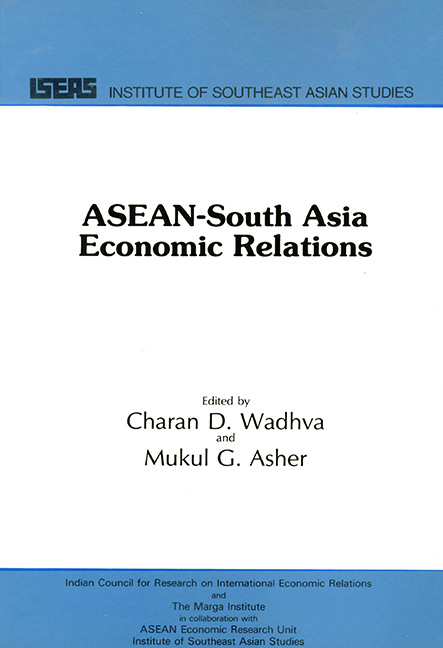Book contents
- Frontmatter
- Contents
- Foreword
- Exchange Rates of ASEAN and South Asian Countries
- An Overview
- PART ONE ASEAN COUNTRY STUDIES
- PART TWO SOUTH ASIA COUNTRY STUDIES
- Bangladesh-ASEAN Trade Relations
- Bangladesh-ASEAN Investment Relations
- India-ASEAN Economic Relations
- Nepal-ASEAN Economic Relations
- Sri Lanka-ASEAN Economic Relations
- Postscript
- Appendix SITC Classification at One-, Two-, and Three-digit Levels
- THE EDITORS
India-ASEAN Economic Relations
from PART TWO - SOUTH ASIA COUNTRY STUDIES
Published online by Cambridge University Press: 21 October 2015
- Frontmatter
- Contents
- Foreword
- Exchange Rates of ASEAN and South Asian Countries
- An Overview
- PART ONE ASEAN COUNTRY STUDIES
- PART TWO SOUTH ASIA COUNTRY STUDIES
- Bangladesh-ASEAN Trade Relations
- Bangladesh-ASEAN Investment Relations
- India-ASEAN Economic Relations
- Nepal-ASEAN Economic Relations
- Sri Lanka-ASEAN Economic Relations
- Postscript
- Appendix SITC Classification at One-, Two-, and Three-digit Levels
- THE EDITORS
Summary
Economic relations through trade between India and the five member countries of the Association of Southeast Asian Nations (ASEAN) – formed in 1967 – namely, Indonesia, Malaysia, Philippines, Singapore, and Thailand, have a long history. This is especially so in the case of Indonesia, Malaysia, Singapore and Thailand where the influence of Indian culture is readily evident even today and is reinforced by a sizeable population of Indian origin living in these countries. Even the settlement of some Indians in the Philippines is a story which is a few decades old. Our purpose is not to authenticate this part of the world history but, within this historical background, to trace the present state of economic relations between India and the ASEAN countries especially since 1970 and to analyse the prospects for economic co-operation among these countries in the near future.
In this context, economic relations can be conveniently divided into three parts, namely, trade-based relations, investment- (and joint venture) based relations, and all other economic relations based on services such as tourism, shipping, and banking. Accordingly, this paper is divided into three main sections. Section I deals with the survey of trade relations; Section II with the survey of investment relations with special reference to the joint industrial ventures; and Section III with the survey of “other” economic relations. The concluding section (Section IV) highlights some of the prospective areas for expanding economic co-operation between India and the ASEAN countries.
TRADE RELATIONS
Table 1 presents data relating to India's exports, imports, and trade balance with the ASEAN countries and the world for the year 1971/72 and 1976/77 to 1979/80. Table 2 presents the rates of growth of exports and imports based on Table 1.
Growth of Trade
Trade between India and the ASEAN countries as a regional grouping as well as with the individual countries of this grouping grew at a rapid rate during the decade 1971/72 to 1979/80.
- Type
- Chapter
- Information
- ASEAN-South Asia Economic Relations , pp. 269 - 320Publisher: ISEAS–Yusof Ishak InstitutePrint publication year: 1985

